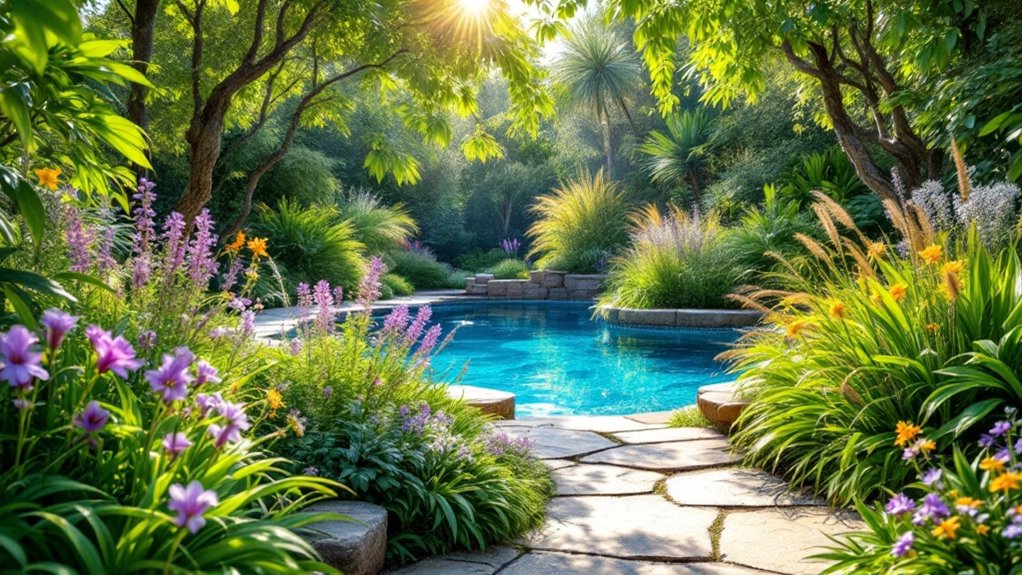Sustainable swimming pool designs present a range of advantages that appeal to environmentally conscious homeowners. These pools prioritize energy efficiency and water conservation, greatly lowering utility costs. They also utilize eco-friendly materials, creating a healthier swimming environment. Additionally, such designs can enhance property value. However, the full extent of these benefits extends beyond mere aesthetics and functionality, leading to a deeper consideration of their impact on both personal wellness and the broader ecosystem.
Energy Efficiency and Reduced Utility Costs
Sustainable swimming pool designs prioritize energy efficiency, greatly lowering utility costs for homeowners. By incorporating energy-efficient pumps, heaters, and filtration systems, these pools minimize electricity consumption while maintaining ideal performance. Advanced technologies, such as variable-speed pumps, allow for tailored operation, further reducing energy use. Additionally, using solar pool covers can considerably decrease heat loss, allowing for a warmer swimming experience without excessive heating costs. The choice of materials also plays a vital role; energy-efficient insulation and reflective surfaces can enhance the pool’s thermal performance. Overall, sustainable designs not only contribute to a reduced carbon footprint but also provide long-term financial benefits, making them an attractive option for environmentally conscious homeowners seeking to cut down on utility expenses. Moreover, older systems tend to be less efficient than newer ones, emphasizing the importance of upgrading to modern technology for optimal performance.
Water Conservation and Management
Effective water conservation and management are integral components of eco-friendly swimming pool designs. Sustainable pools employ advanced filtration systems that minimize water waste, ensuring that less water is required for maintenance. Rainwater harvesting systems can be integrated to collect and utilize natural precipitation for pool filling and landscaping needs, further reducing reliance on municipal water supplies. Additionally, the use of automatic covers prevents evaporation, considerably conserving water during periods of non-use. Smart technology can also monitor water levels and detect leaks, enabling prompt repairs and minimizing losses. By incorporating these strategies, sustainable swimming pools not only enhance water efficiency but also contribute to broader environmental conservation efforts, making them a responsible choice for modern homeowners.
Eco-Friendly Materials and Construction
Choosing eco-friendly materials and construction methods plays an essential role in creating environmentally responsible swimming pools. Utilizing sustainable materials such as recycled glass, natural stone, or sustainably sourced wood minimizes environmental impact while enhancing aesthetic appeal. Additionally, opting for concrete alternatives, like rammed earth or recycled plastic composites, can also reduce the carbon footprint associated with pool construction.
Implementing energy-efficient building practices, such as modular construction and prefabrication, can streamline the building process and limit waste. Moreover, using non-toxic sealants and finishes contributes to a healthier ecosystem around the pool. By prioritizing these eco-friendly choices, pool designers and homeowners can promote sustainability, ensuring that swimming pools not only serve recreational purposes but also align with environmental stewardship.
Healthier Swimming Environment
A healthier swimming environment is crucial for enhancing the overall experience of pool users while promoting safety and well-being. Sustainable swimming pool designs often incorporate advanced filtration systems and natural water treatment methods, minimizing chemical use. This reduction in harsh chemicals, such as chlorine, lowers the risk of skin irritations and respiratory issues among swimmers. Additionally, using non-toxic materials for pool surfaces and surroundings also contributes to a safer atmosphere. Proper circulation and regular maintenance guarantee that water quality remains high, reducing the likelihood of algae buildup and other contaminants. Moreover, integrating landscaping that filters runoff enhances overall water quality. By focusing on these aspects, sustainable pools create a more enjoyable and healthier environment for everyone involved. Regular service and maintenance ensures safe swimming environment, which is vital for the health of all pool users.
Increased Property Value and Appeal
Sustainable swimming pool designs not only enhance the health and safety of users but also considerably boost property value and appeal. Homebuyers increasingly prioritize eco-friendly features, recognizing that sustainable pools reduce long-term operational costs through energy-efficient systems and water conservation. Such designs often incorporate natural filtration methods and solar heating, which align with modern environmental values. Additionally, attractive landscaping and innovative pool shapes contribute to a home’s aesthetic, making properties with sustainable pools more desirable. As a result, sellers can command higher prices and attract a broader range of potential buyers. Ultimately, investing in sustainable swimming pool designs can transform an ordinary backyard into a premium asset, enhancing both financial returns and the overall enjoyment of the property. Furthermore, careful planning and consultation with professionals ensures that the design is tailored to specific preferences and complies with local regulations.
Frequently Asked Questions
How Do Sustainable Pools Impact Local Wildlife and Ecosystems?
Sustainable pools positively influence local wildlife and ecosystems by reducing chemical runoff, promoting biodiversity, and providing habitats. Their design often incorporates native plants, which support local fauna, ultimately leading to healthier and more resilient ecosystems.
What Maintenance Practices Support Sustainable Swimming Pool Designs?
Proper maintenance practices for sustainable swimming pools include regular water testing, eco-friendly cleaning methods, energy-efficient pumps, and natural filtration systems. These practices enhance water quality while minimizing chemical use and reducing environmental impact.
Are There Specific Plants Recommended for Landscaping Around Eco-Friendly Pools?
In landscaping around eco-friendly pools, native plants, drought-resistant varieties, and those requiring minimal maintenance are often recommended. These selections enhance biodiversity, reduce water usage, and contribute to a sustainable environment surrounding the swimming area.
Can I Retrofit My Existing Pool to Make It More Sustainable?
Retrofitting an existing pool for sustainability is feasible. Options include installing energy-efficient pumps, solar heating systems, and advanced filtration methods. Additionally, integrating natural landscaping and using eco-friendly materials can enhance the pool’s overall environmental impact.
How Do Sustainable Pools Affect Insurance Rates and Policies?
Sustainable pools can influence insurance rates and policies by potentially lowering premiums due to reduced environmental impact and energy efficiency. Insurers may offer discounts for eco-friendly features, recognizing their value in mitigating risks associated with traditional pools.
Conclusion
To summarize, sustainable swimming pool designs present a multitude of advantages, encompassing energy efficiency, water conservation, and the use of eco-friendly materials. These innovative features not only foster a healthier swimming environment but also enhance property value and appeal. By prioritizing sustainability, pool owners can greatly reduce operational costs while positively impacting the surrounding ecosystem. Ultimately, the integration of these practices in pool design represents a forward-thinking approach to recreation that aligns with contemporary environmental values.




